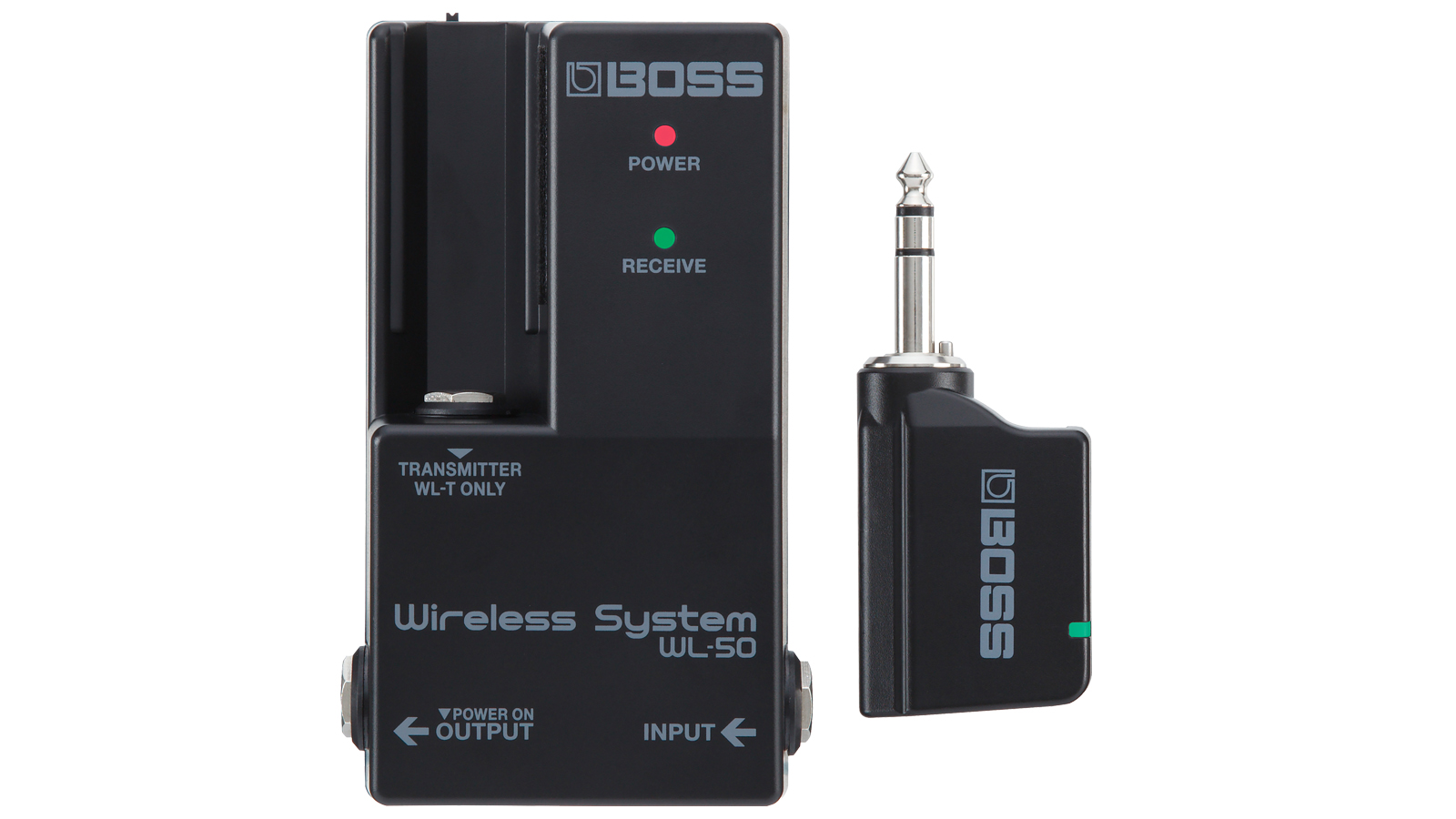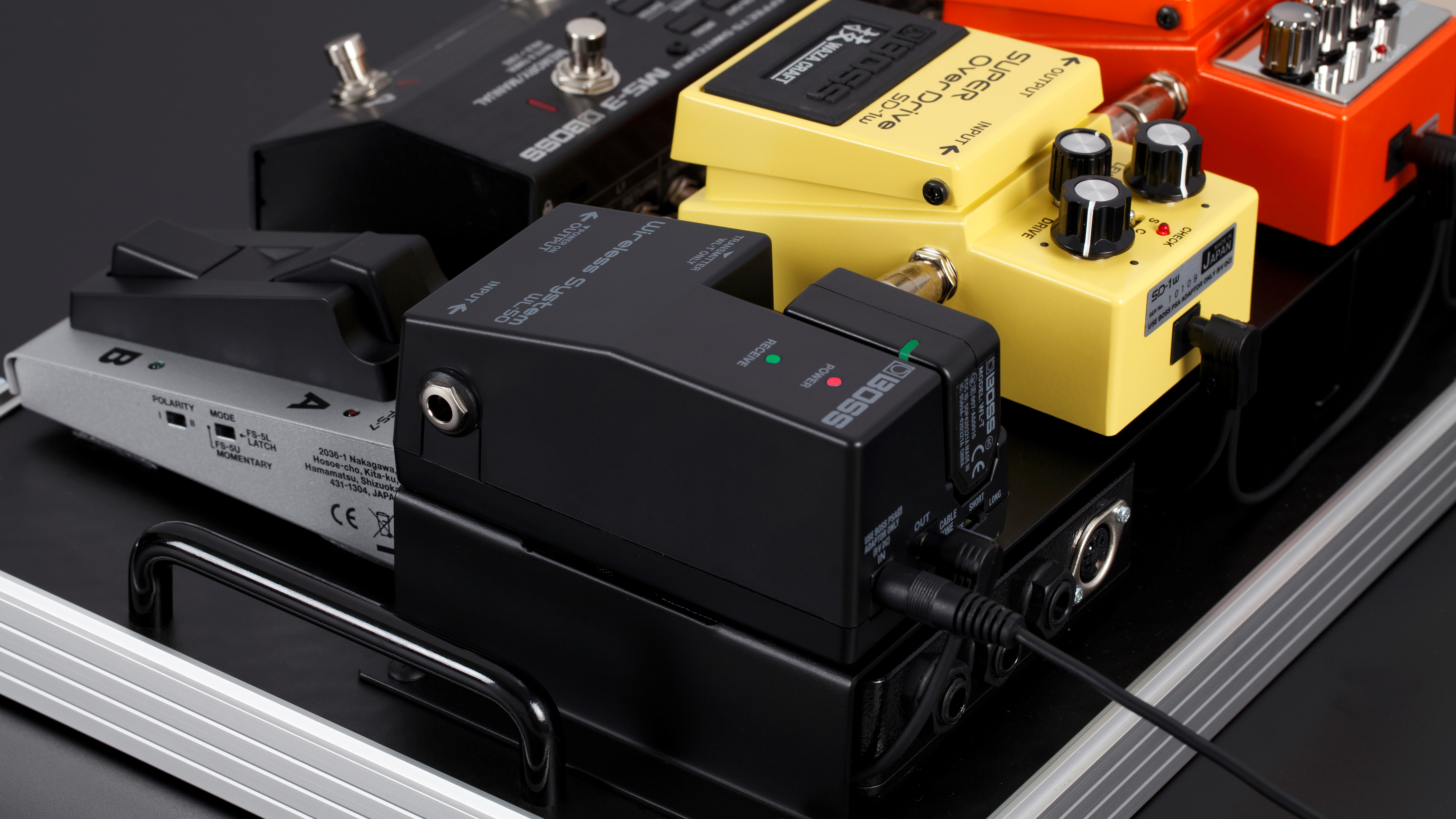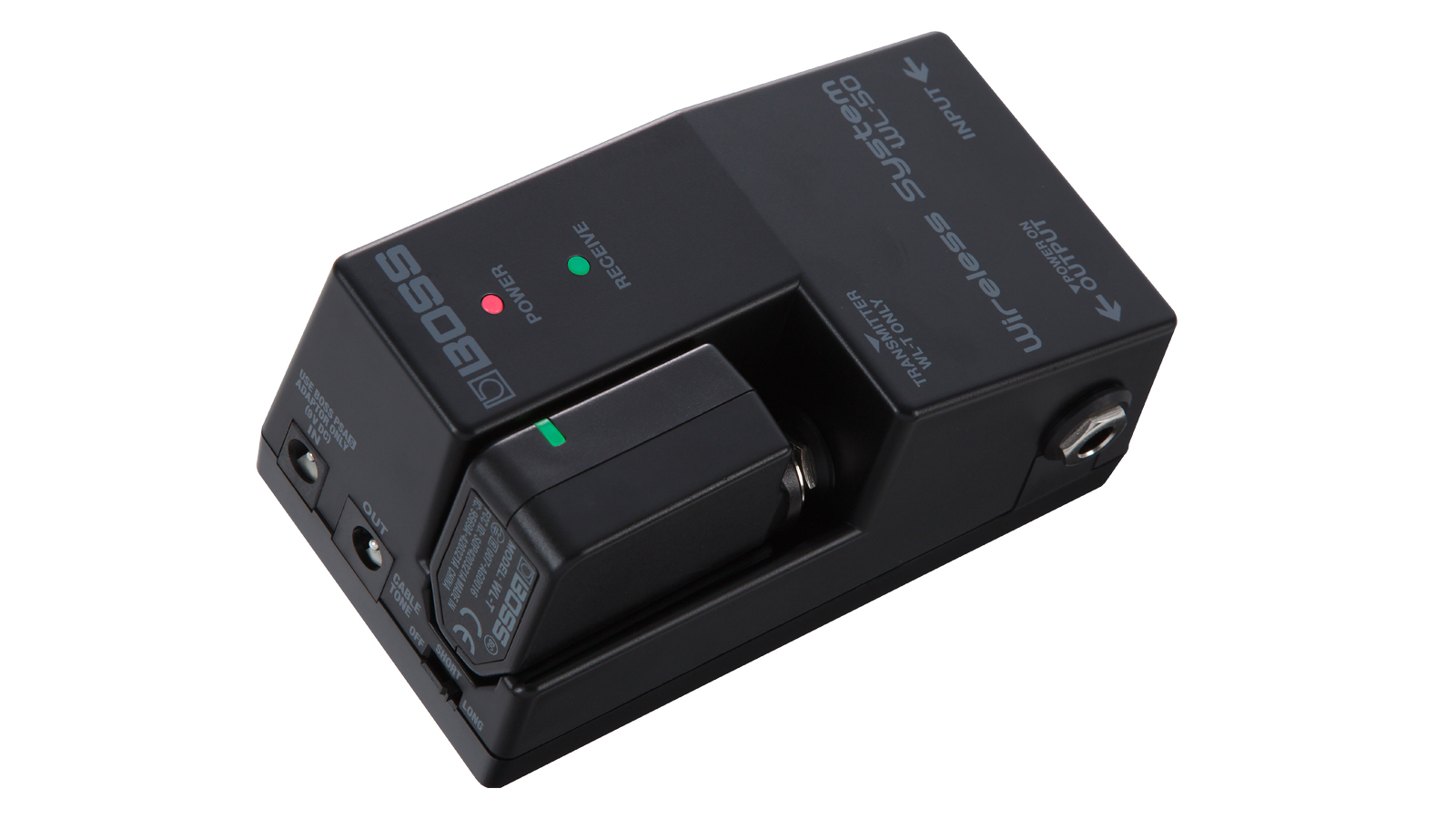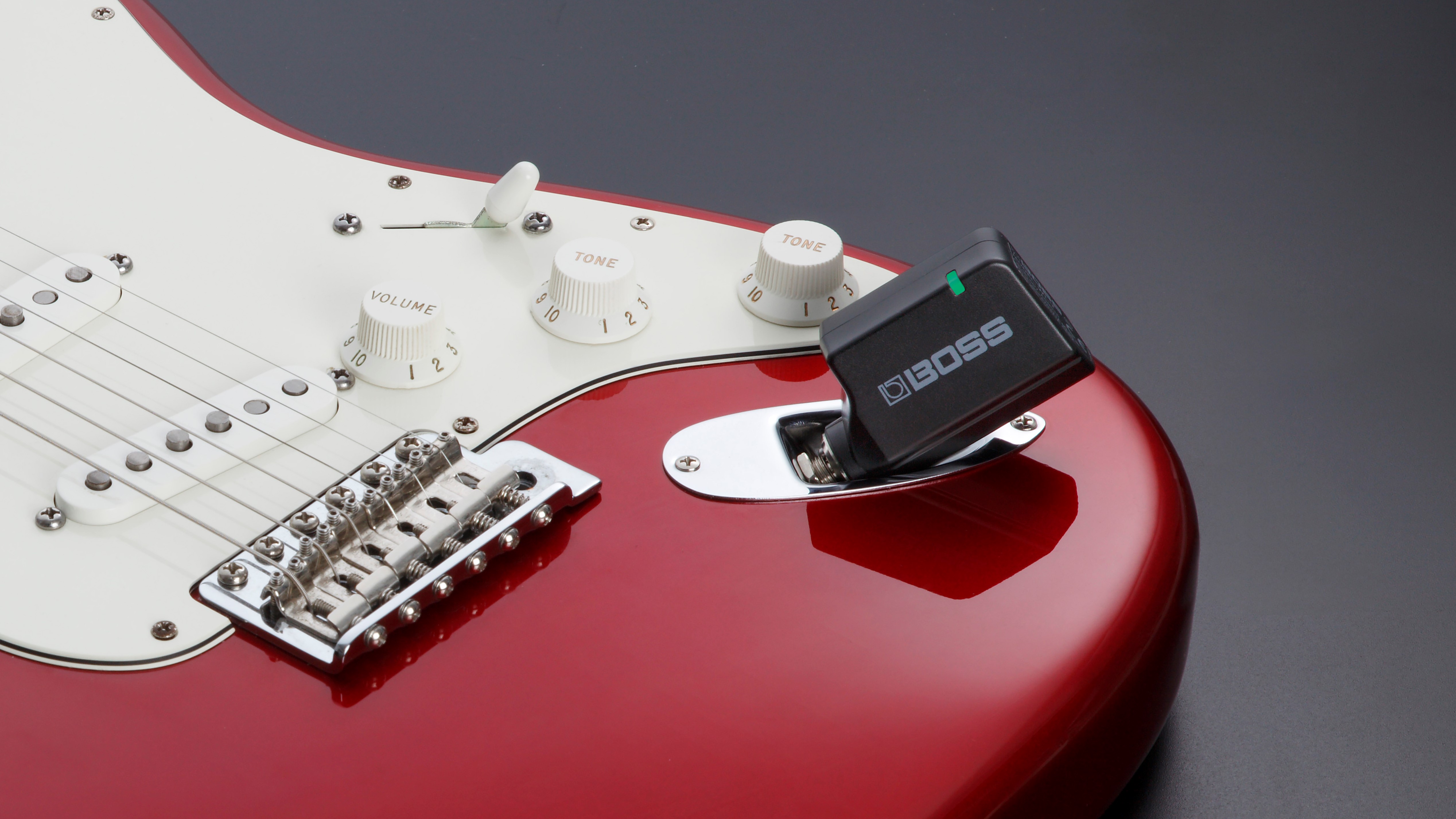MusicRadar Verdict
For guitarists and bassists using a pedalboard, this is one of the top wireless systems out there. The WL-50 is packed full of features with only a few minor flaws.
Pros
- +
Fits neatly on a pedalboard
- +
Covers a good distance
- +
Battery level LED
- +
Powers other pedals
Cons
- -
Transmitter may get in the way on some guitars
- -
Some active pickups may need an adaptor
MusicRadar's got your back
Boss WL-50 review: What Is It?
The Boss WL-50 is a wireless guitar system comprising a transmitter and receiver that’s roughly the same size as a regular Boss compact pedal. It’s been designed to fit on your pedalboard so that you can get rid of the cable that would normally run between your guitar/bass and your pedals.
The Boss WL-50 gives you freedom to walk around the stage or rehearsal room, without worrying about getting your cables tangled up. Weave in between band members, or even wander out into the crowd without the restrictions you’d normally face with a traditional guitar cable.
It’s a neat design, and when placed on a pedalboard, doesn’t look at all out of place. It runs off a regular 9V power supply (Boss recommends you use their PSA-S plug, but any decent unit will do the job), so you don’t need to start running different plugs into your board, though you can also run it using a pair of AA batteries. The transmitter jack slots nicely into the receiver and, when using mains power, the receiver acts as a charging port for it. You’ve also got the option of charging the transmitter via USB too.
It manages to pack quite a few handy features into such a small footprint. There’s a power output on the back so when powering it via mains, you can run a daisy chain out of it to power other pedals. As well as an output jack to run to your pedals, or guitar amp, there’s an input jack so you can just run a cable into it should you experience any wireless problems during a show. You’ve also got a switch that lets you simulate the tonal characteristics of running different length cables.
Boss WL-50 review: Performance & verdict

One of the first things to note about the Boss WL-50 is how easy it is to use. Once the transmitter is charged up, simply dock it with the receiver for around 10 seconds and they’ll automatically pair. It’s got 14 channels available which accounts for playing in rooms with WiFi, or other wireless systems, plus it will automatically sense the best channel to use so you don’t get interference. With the Boss WL-50, you don’t need to tune into the right frequency - it does it all for you.
Boss states that the WL-50 has a 20 metre range, with line-of-sight propagation. We didn’t quite get the measuring tape out, but it covers a fair distance without dropping out. We even left the room and continued to play without the signal faltering. Only when we went down the hall and into another room (probably 15+ metres away) did the signal drop out. When playing gigs, you can roam around the stage, or even around the room, and you’ll be covered within a good distance. This also really comes in handy at soundcheck - you can leave the stage and continue to play, so you can hear the front of house sound.

Xvive U2 Wireless System
Line 6 Relay G10S MKII
Shure BLX14UK-K3E
The signal coming from the amp is absolutely fine - nothing noteworthy, which is a good thing. There’s no lag when playing, even when you’re a distance away from the receiver. The cable tone switch on the back lets you replicate the loss in treble frequencies that you normally get with a longer cable, if that’s what you’re used to hearing. You can also use a ‘short cable’, or have it switched off (ideal for active pickups and acoustics) - you can hear it, but the difference in sound isn’t massive.
Another handy little feature on the transmitter of the WL-50 is that there’s a tiny on/off button that’s depressed when plugged into a guitar input. This means that it’s only active when plugged into a guitar, so you don’t get that nasty pop when you take the transmitter out, as you would do with most traditional cables.
However, this feature also means that when it’s plugged into the receiver and the receiver isn’t powered on (and therefore isn’t charging it), they’re put into standby mode which does very slowly drain the battery. An easy solution to this is to simply pull the transmitter out of the receiver a touch, so it still sits neatly in place, but doesn’t depress the button.

The WL-50 looks great, and it’s unintrusive. It’s about the same size as a regular stompbox, so it’s easy to fit in alongside all your other pedals. The fact that it’s powered in the same way as the rest of your pedals also makes life easier. If you forget to charge your transmitter at home, you can turn up to a show and get an hour or so charging time between soundcheck and show time, and you’ll be good to go. The handy LED light on the transmitter lets you know how your battery is faring - when it goes to an amber light, you’ve got less than two hours left - if it goes to red, then you’ll probably want to finish the song and use a cable for the rest of your set.
Boss says that you’ll get 10 hours playtime out of it, and whilst we’ve not tested the full 10 hours out, we gave it a good play through for a few hours and it remained green the whole time.
A couple of minor concerns with the WL-50 is that some guitars with certain active pickups might need a stereo to mono jack converter; otherwise there may be some interference or it might not work at all.
Another thing is that there’s no option to angle the jack plug at all - the transmitter is a rigid unit. Most of the time, this won’t be an issue - it fit perfectly in all the guitars we tried it with - Strat, Tele, Les Paul, P-Bass and more. However, in a Jazzmaster, and no doubt some other guitars, you do notice it a little more than if you were using a regular cable. If you’re an enthusiastic strummer, you might accidentally knock it. That said, you’d probably get used to it after time.
Boss WL-50 review: Hands-on Demos
PMTV UK

Alberto Martinez Del Rio

Boss
Boss WL-50 review: Specifications
- Compatible Channels: 14
- Range: Up to 65 feet line-of-sight (May vary due to local conditions)
- Latency: 2.3 ms
- Connectors: Input Jack, Output Jack, Transmitter Jack, DC In Jack, DC Out Jack
- Power Supply: Alkaline battery (AA, LR6) x 2 or AC adaptor
- Current Draw: During wireless operation, 60 mA; while charging transmitter, 320 mA
- Expected battery life under continuous use: Alkaline battery (AA, LR6), approximately 10 hours
- Contact: Boss
After spending a decade in music retail, Richard is now a freelance writer for MusicRadar, Guitar Player, Guitar World and Reverb, specialising in electric and acoustic guitars, bass, and almost anything else you can make a tune with. When his head’s not buried in the best of modern and vintage gear, Richard runs a small company helping musicians with songwriting, production and performance, and plays bass in an alt-rock band. Otherwise, you'll probably find him out walking the dog!
“We are so unencumbered and unbothered by these externally imposed rules or other people’s ideas for what music should be”: Blood Incantation on the making of Absolute Elsewhere and how “Data from Star Trek” saved the album – and the studio
“Delivers streamlined DAW integration with an excellent hammer action keyboard”: Arturia Keylab 88 Mk3 review
“I have an original 909 – every time I try to use it I feel like I’m ruining it”: House hero Riva Starr on his studio essentials and his love of analogue synths












